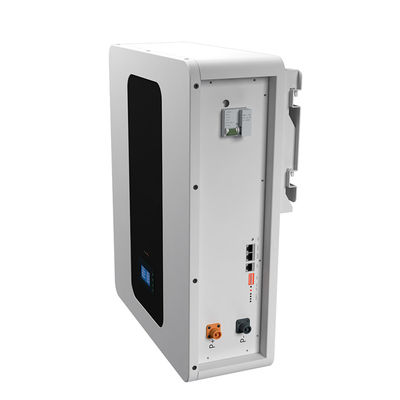






| Protection Class: | IP65 |
|---|---|
| Weight: | 48kg±3kg |
| Nominal Capacity: | 100Ah |
| Nominal Power: | 10.24KWh(95%DOD) |
| Grid Connection: | Hybrid Grid |
| Protection Class: | IP65 |
|---|---|
| Weight: | 48kg±3kg |
| Nominal Capacity: | 100Ah |
| Nominal Power: | 10.24KWh(95%DOD) |
| Grid Connection: | Hybrid Grid |
| Highlight: | 5kwh Lifepo4 Battery,IP65 Lifepo4 Battery,100Ah Lifepo4 Battery |
| Minimum Order Quantity: | 10 |
|---|---|
| Price: | negotiated price |
| Packaging Details: | solar power station carton packaging |
| Delivery Time: | 5-14 work days |
| Payment Terms: | Western Union, MoneyGram |
| Supply Ability: | 1000+PCS+1000 per week |
Energy Storage Battery ESS 100Ah 5kwh Lifepo4 Battery
The 51.2V 100Ah battery system is applicable to home energy storage, small or medium sized shopping mall energy storage,which uses 32 pieces of 3.2V 50Ah battery cells in 16s2p configuration.Built-inSeplos smart BMS suppor tmaximumof 16packs of battery in paralleltoachieve high ercapacity.The system can not becon nected in series.And do not mixusea ocell battery with anyother battery brands or models.
O'Cell is committed to providing high-quality solar inverter solutions that help to power a greener future. With its advanced technology,flexible design, and user-friendly interface, [Inverter Model] is the ideal choice for anyone looking to harness the power of the sun and make the switch to clean, renewable energy.
![]()
|
Items
|
Specifications
|
|
Rated energy(kWh)
|
5.12KWh
|
|
Configuration
|
2P16S
|
|
Nominal Voltage(V)
|
51.2V
|
|
Working Voltage(V)
|
42V~58.4V
|
|
Nominal Capacity(Ah)
|
100Ah
|
|
Rated charge/discharge Current(A)
|
50A@25±2℃
|
|
Maximum charging current
|
100A@25±2℃
|
|
Maximum discharge current
|
100A@25±2℃
|
|
Working Temperature
|
0~40℃(Charge) -20~40℃(Discharge)
|
|
Humidity(%)
|
5~95%
|
|
Altitude Limited(m)
|
0-3000m
|
|
Dimension(mm)
|
580×460×172.4mm
|
|
Storage temperature and humidity
|
-10℃~35℃(Within one month of storage)
25±2℃(Within three months of storage) 65%±20%RH |
|
weight
|
48kg±3kg
|
|
cycle life
|
4800 cycles @25℃
50A charge and discharge current 70% standard capacity 90% DOD |
|
Communication mode
|
CAN&RS485
|
![]()
![]()
1. How can I calculate the capacity of an energy storage battery I need for my home?
To calculate the capacity, determine your daily energy consumption and desired backup period. Multiply the daily consumption by the backup period to get the required capacity. It's recommended to consult with a professional for accurate sizing.
2. Can energy storage batteries be connected to solar panels or wind turbines?
Yes, energy storage batteries are commonly paired with solar panels and wind turbines to store excess energy generated during sunny or windy periods for later use when energy generation is low.
3. What is the maintenance required for energy storage batteries?
Maintenance typically involves regular inspections, temperature monitoring, and ensuring proper ventilation. Lithium-ion batteries generally require less maintenance than lead-acid batteries.
4. Are there government incentives or subsidies for installing energy storage batteries?
In some regions, there are incentives and subsidies available for installing energy storage batteries as part of renewable energy systems. Check with local authorities or energy agencies for specific programs in your area.
5. Can energy storage batteries be recycled?
Yes, many components of energy storage batteries, especially lithium-ion batteries, can be recycled. Recycling helps reduce environmental impact and recover valuable materials.
6. Are energy storage batteries safe?
Energy storage batteries are generally safe when used and maintained properly. They have built-in safety features and are designed to minimize the risk of accidents. However, it's crucial to follow manufacturer guidelines and safety precautions